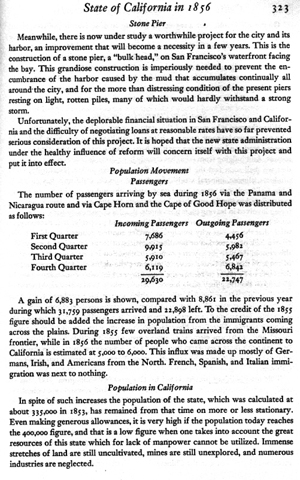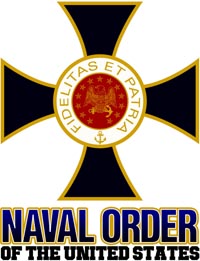News & Tall Tales. 1800s.

Stone Pier
State of California in 1856
Stone Pier

Meanwhile, there is now under study a worthwhile project for the city and its harbor, an improvement that will become a necessity in a few years.
This is the construction of a stone pier, a "bulk head," on San Francisco's waterfront facing the bay. This grandiose construction is imperiously needed to prevent the encumbrance of the harbor caused by the mud that accumulates continually all around the city, and for the more than distressing condition of the present piers resting on light, rotten piles, many of which would hardly withstand a strong storm.
Unfortunately, the deplorable financial situation in San Francisco and California and the difficulty of negotiating loans at reasonable rates have so far prevented serious consideration of this project.
It is hoped that the new state administration under the healthy influence of reform will concern itself with this project and put it into effect.
Population Movement
Passengers
The number of passengers arriving by sea during 1856 via the Panama and Nicaragua route and via Cape Horn and the Cape of Good hope was distributed as follows:
| Incoming | Outgoing | |
| 1st Quarter | 7,686 |
4,456 |
| 2nd Quarter | 9,915 |
5,982 |
| 3rd Quarter | 5,910 |
5,467 |
| 4th Quarter | 6,119 |
6,842 |
| Totals | 29,630 |
22,747 |
A gain of 6,883 persons is shown,compared with8,861 in the previous year during which 31,759 passengers arrived and 22,898 left. To the credit of the 1855 figure should be added the increase in population from the immigrants coming across the plains. During 1855, few overland trains arrived from the Missouri frontier, while in 1856 the number of people who came across the continent to California is estimated at 5,000 to 6,000. This influx was made up mostly of Germans, Irish, and Americans from the North.
French, Spanish, and Italian immigration was next to nothing.
Population in California
In spite of such increases, the population of the state, which was calculated at about 335,000 in 1853, has remained from that time on more or less stationary. Even making generous allowances, it is very high if the population today reaches the 400,000 figure when one takes into account the great resources of this state which for lack of manpower cannot be utilized. Immense stretches of land are still uncultivated, mines are still unexplored, and numerous industries are neglected.
The California Historical Society Quarterly
Federico Biesta's Report to the
Sardinian Ministry of Foreign Affairs
The Irish Way: Becoming American in the Multiethnic City (Penguin History of American Life)
A lively, street-level history of turn-of-the-century urban life explores the Americanizing influence of the Irish on successive waves of migrants to America's cities.
James R. Barrett
In this award-winning Penguin History of American Life series, James R. Barrett chronicles how a new urban American identity was forged in the streets, saloons, churches, and workplaces of the American city. This process of “Americanization from the bottom up” was deeply shaped by the Irish. From Lower Manhattan to the South Side of Chicago to Boston’s North End, newer waves of immigrants and African Americans found it nearly impossible to avoid the Irish. While historians have emphasized the role of settlement houses and other mainstream institutions in Americanizing immigrants, Barrett makes the original case that the culture absorbed by newcomers upon reaching American shores had a distinctly Hibernian cast.
By 1900, there were more people of Irish descent in New York City than in Dublin; more in the United States than in all of Ireland.
Barrett reveals how the Irish vacillated between a progressive and idealistic impulse toward their fellow immigrants and a parochial defensiveness stemming from the hostility earlier generations had faced upon their own arrival in America. They imparted racist attitudes toward African Americans; they established ethnic “deadlines” across city neighborhoods; they drove other immigrants from docks, factories, and labor unions. Yet the social teachings of the Catholic Church, a sense of solidarity with the oppressed, and dark memories of poverty and violence in both Ireland and America ushered in a wave of progressive political activism that eventually embraced other immigrants. Drawing on contemporary sociological studies and diaries, newspaper accounts, and Irish American literature.
The Irish Race: In California, and On The Pacific Coast (1878)
Hugh Quigley
The Irish Americans
A History
Jay P. Dolan of Notre Dame University is one of America’s most acclaimed scholars of immigration and ethnic history. Although more than 30 million Americans claim Irish ancestry, no other general account of Irish American history has been published since the 1960s. Dolan draws on his own original research and much other recent scholarship to weave an insightful, colorful narrative. He follows the Irish from their first arrival in the American colonies through the bleak days of the potato famine that brought millions of starving immigrants; the trials of ethnic prejudice and "No Irish Need Apply;" the rise of Irish political power and the heyday of Tammany politics.
The Cross and the Shamrock Or, How To Defend The Faith. An Irish-American Catholic Tale Of Real Life, Descriptive Of The Temptations, Sufferings, Trials ... And Female Servants Of The United States.
Hugh Quigley
Written in the mid-1800s.
Irish Californians: Historic, Benevolent, Romantic
Patrick Dowling has written a collection of brief biographies of Irish immigrants that he found admirable. Published when Patrick was 94, this book contains his personal choices of Irish heroes, entrepreneurs, and colorful characters, arranging from Timothy Murphy, who came to California before the American conquest, to Thomas Sweeny, who tried to invade Canada, to Eleanor Martin, who was the doyenne of San Francisco high society. Index and bibliography. 120 illustrations.
How the Irish Saved Civilization
The Untold Story of Ireland's Heroic Role From the Fall of Rome to the Rise of Medieval Europe
(The Hinges of History)
Thomas Cahill
In this entertaining and compelling narrative, Thomas Cahill tells the story of how Europe evolved from the classical age of Rome to the medieval era. Without Ireland, the transition could not have taken place. Not only did Irish monks and scribes maintain the very record of Western civilization -- copying manuscripts of Greek and Latin writers, both pagan and Christian, while libraries and learning on the continent were forever lost -- they brought their uniquely Irish world-view to the task.

 AncestryDNA: Genetic Testing
AncestryDNA: Genetic Testing
This service combines advanced DNA science with the world's largest online family history resource to predict your genetic ethnicity and help you find new family connections. It maps ethnicity going back multiple generations and provides insight into such possibilities as: what region of Europe are my ancestors from, or am I likely to have East Asian heritage? AncestryDNA can also help identify relationships with unknown relatives through a dynamic list of possible DNA member matches.

The Naval Order of the United States has a history dating from 1890. Membership includes a wide range of individuals, many with highly distinguished career paths.
The San Francisco Commandery meets the first Monday of each month at the San Francisco Italian Athletic Club in San Francisco, California and holds two formal dinners each year.






 Copyright ~ 1998-2018.
Copyright ~ 1998-2018. 